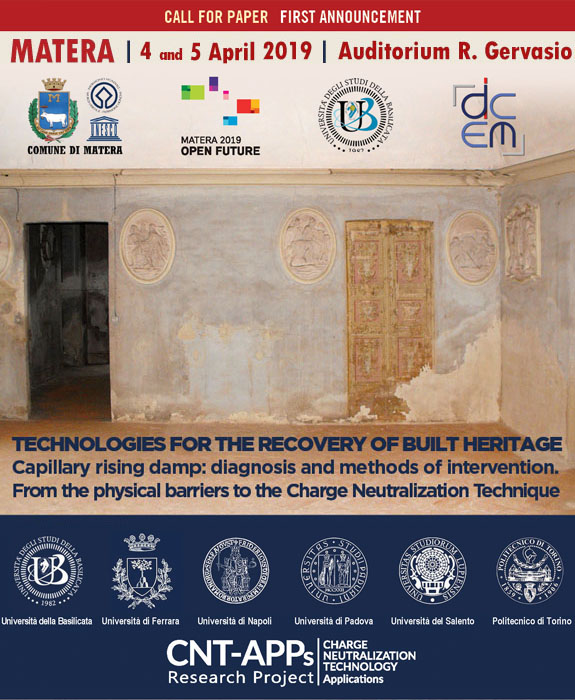 TECHNOLOGIES FOR THE RECOVERY OF BUILT HERITAGE
TECHNOLOGIES FOR THE RECOVERY OF BUILT HERITAGE
Capillary rising damp: diagnosis and methods of intervention.
From the physical barriers to the Charge Neutralization Technique
The masonry walls pathologies caused by the damp phenomena represent the most widespread forms of deterioration of the built heritage and, in particular, of the cultural assets. The porous nature of building materials smooth the progress of the moisture content penetration into the wall structures that, rich in salts, negatively affects the mechanical and thermal characteristics of the load-bearing elements and the building veneer, often affecting the healthiness of the rooms and the preservation of precious decorative layers.
Despite the widespread diffusion of such pathologies and the harmful effects on safety, health, and conservation of cultural built heritage, wall dampness has always been considered a “second order” issue with regards to the seismic and energetic topics that have engaged most of the academic resources. Scientific research in the field of capillary rising damp, mainly developed by sectorial enterprises, has not identified -aside from particular exceptions- system, process and product innovations, sufficiently tested and resolved for those pathologies connected to the different “damp typologies.” Among these indeed emerge those caused by the capillary rising damp into the historical, artistic and monumental building heritage walls.
The rising action, caused by the natural attraction that the capillary system of the materials exerts through simple contact with the water molecules present in the subsoil, represents the field of greatest operational and research complexity. The attempt to remove the source by isolating the existing wall structures from the foundation soil has involved many scholars, in the past, to focus on methods (i.e., mechanical, chemical, evaporative and electrical approaches) which were able to block the arising, to support the disposal of the internal water content or to contrast the rise by introducing artificial electric fields into the walls. The most promising technological innovation, supported by numerous scientific experiments, is the “Charge Neutralization Technique” (TNC). The proposed methodology, posing as an evolution of traditional electrical interventions, entrusts its effectiveness to the action of a weak electromagnetic field which, spreading by air, frees its efficacy from the particular wall system and acts on the electric water behaviour, countering the recall actions within the capillary system.
The Conference aims to raise up the debate focussing on the masonry pathologies caused by damp phenomena, with particular reference to the weathering action backed by capillary rising damp, supporting the need to define a scientific method for the design of retrofit interventions based on a correct succession of diagnosis stages, qualification and application of technologies and testing of interventions.
TOPICS
A Managing damp problems in built heritage, health, safety, and environmental comfort
B Tools and methods for the diagnosis, the extent assessment, and the result impact evaluation
C Techniques and methods of intervention: treatments and tests
CALL FOR ABSTRACT
The Conference will be held in MATERA on April 4 and 5, 2019
at the Auditorium R. Gervasio – Piazza del Sedile 2.
DEADLINE
Abstract Submission Deadline: 15/01/2019
Abstract Notification of Acceptance: 31/01/2019
Full paper Submission Deadline: 28/02/2019
Full paper Notification of Acceptance: 15/03/2019
Submission deadline for the final reviewed version of the Proceeding Papers: 31/03/2019
NOTES FOR THE AUTHORS
The authors are invited to submit a paper proposal (written according to the template download here) by October 31, 2018, to the following email address: info@cnt-apps.com
The proposal, written as a short abstract, should clearly indicate the title, the information related to the author/s (e.g., academic affiliation, phone number and email of each author or co-author), the content text, the objective of the full paper, the methodology, the results, the practical implications, the limits of the research, and the originality of work.
Upon the submission of the abstract, authors are asked to indicate in which session (i.e., topic A, B, and C) they wish to present their paper and include a short CV (max. 400 words) in pdf.
By submitting the paper proposal, at least one of the authors agrees to be present at the conference.
The Scientific Committee will double peer review all the paper proposals.
Official languages of the conference: Italian and English
DOWNLOAD THE ABSTRACT TEMPLATE
For more information please visit the website: www.cnt-apps.com or contact the conference secretariat: info@cnt-apps.com
Please, feel free to forward this call for papers to those potentially interested in taking part to the conference.
CONFERENCE SCIENTIFIC COMMITTEE
Raymond Bondin (Ambasciatore Emerito di Malta presso UNESCO)
Antonella Guida, Antonello Pagliuca, Antonio Bixio, Antonio Conte, Graziella Bernardo,
Michele D’Amato, Nicola Cardinale, Nicola Masini (Università degli Studi della Basilicata)
Manlio Montuori (Università degli Studi di Ferrara)
Mercedes Del Rio Merino (Universidad Politécnica de Madrid)
Roberto Castelluccio (Università Federico II – Napoli)
Claudio Modena (Università di Padova)
Paolo Maria Congedo (Università del Salento – Lecce)
Carlo Ostorero, Giorgio Zavarise (Politecnico di Torino)
ORGANIZING SECRETARIAT
Leonardo Solutions Srl
Corso Sempione 215 – 20025 Legnano
Tel. 0331 454845 – email: info@cnt-apps.com
ORGANIZING SECRETARIAT
“Erly bird” registration (by 31/12/2018): € 220 per author
Regular Rate (after 31/12/2018): € 280 per author
